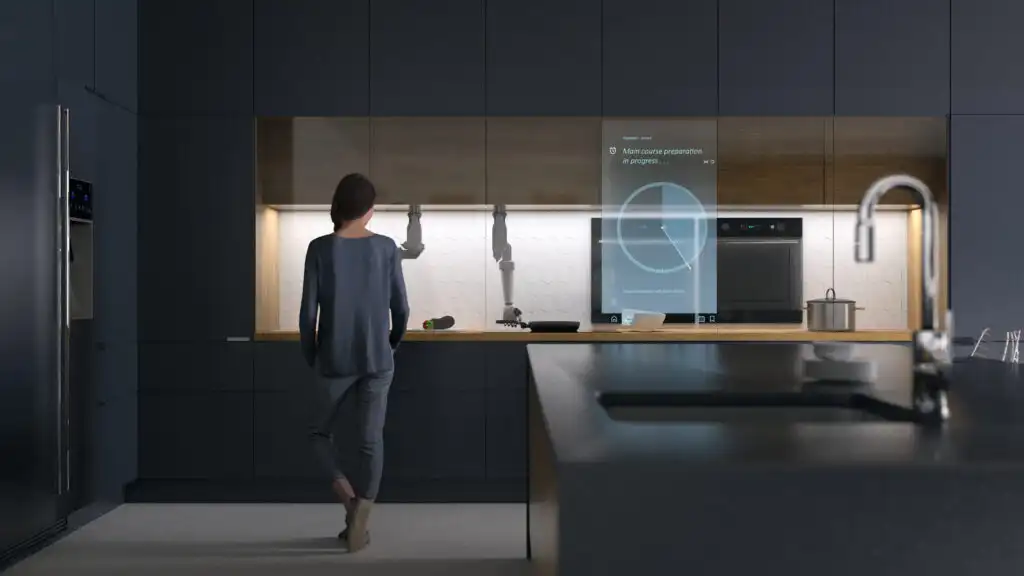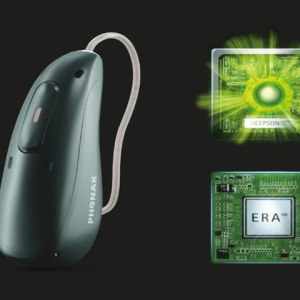
For many at Xerox PARC in the early 1990s, the device seemed almost hypnotic. Consisting of an eight-foot piece of string tied to a small motor, the machine – named Livewire – was designed by Natalie Jeremijenko to be a live representation of the building’s network speeds, spinning faster and faster as traffic climbed. This was ambient computing in one of its purest forms.
As the artist later explained to Fast Company, staff would glance at the device to check if their suspicions of a slow internet connection were justified, or simply comment on its movements like grey clouds on the horizon.
Jeremijenko had been inspired by her boss at Xerox, Mark Weiser. A former computer science professor and now chief technology officer at the company’s research laboratory, Weiser argued that computing had grown too obsessed with devices themselves. While computers were accomplishing more with every passing year, they still yoked their users to the use and maintenance of a single object – in much the same way, he later wrote in an article for Scientific American, to the way a Babylonian scribe had to worry as much about how clay tablets were fired as he did writing in legible cuneiform. Instead, the hallmark of success for a given technology was its invisibility.
“The most profound technologies are those that disappear,” Weiser wrote. “They weave themselves into the fabric of everyday life until they are indistinguishable from it.”
What is ambient computing?
For computing to reach its full potential, argued Weiser, the user would never need to interact with devices through keyboards and screens. Pushing computing in this direction, he continued, would constitute a psychological liberation for the user: no longer would they need to consciously think about how to interact with a keyboard and a screen to perform basic tasks. Ambient computing would, instead, free the user to direct their time and mental energy to other tasks, only interacting with their devices by voice or sight.
Weiser was constrained in demonstrating this vision by the technology of his day, only getting as far as commissioning Livewire and covering the Xerox PARC offices in touchscreens of various sizes. Elements of ambient computing, however, have now come to pass with the slow agglomeration of IoT devices. Smart speakers, for example, are capable of recognising our voices, while smart thermostats can intuit what temperature we prefer our rooms to be heated. Amazon is even sitting on a patent for a smart fridge that uses artificial olfaction to signal when the food inside is spoiling.
Unifying the outputs of these devices into a coherent vision of ambient computing makes smart business sense for major cloud providers, explains Roy Seaward, a partner at Deloitte’s technology practice. “They want to be more than CPU cycles that they charge for,” says Seaward. “The more that they can layer on services around data, around security, around privacy, around trust around AI-style processing, then the more they can monetise that position in the overall value chain.”
Indeed, ambient computing is becoming a central tenet of Big Tech’s outlook. As a spokesperson from Amazon told Tech Monitor, the philosophy is “core to the vision for all our devices and services”. Google believes the same thing. Ambient computing, explained its SVP for devices and services Rick Osterloh, would see users’ devices “work together with services and AI, so help is anywhere you want it, and it’s fluid. The technology just fades into the background when you don’t need it.”
Today, it can hardly be said that the smart speakers and other IoT devices these companies sell live up to this vision. But there are tantalising signs that more concrete aspects of ambient computing may come to pass: see, for example, Google’s work on integrating device readouts into mirrors and wood veneer or Amazon’s efforts in making Alexa more proactive.
If it does, ongoing questions about privacy and interoperability will become more pronounced, even as our computing devices sink from view.

Ambient computing versus the Internet of Things
To some, ambient computing may sound like another way to describe the Internet of Things. Youngjin Yoo disagrees. “IoT is still very device-centric,” explains the professor of information systems at Case Western Reserve University.
Currently, few IoT devices actually communicate with one another. Device designers also tend to focus on just a single application when they’re putting together a given sensor, explains Yoo. Even your typical smart speaker is designed to facilitate dozens of distinct journey paths for requests: for information, say, or playing music. “Alexa will recognise me as a ‘user,’ and I only use Alexa re: the word ‘use,’” says Yoo. “It’s a very narrow view of my activities.”
None of us really live like that, Yoo continues, and a truly ambient computing system would recognise this fact. Not only that, but it would also anticipate and accommodate the individual’s needs throughout the day without forcing them to interact with a screen. If one is needed, advances in miniaturising projectors and the functionality of OLED displays suggest interfaces may soon be capable of being conjured on almost any surface – and beneath them, too, as research from Google into passive-matrix OLED displays recently demonstrated.
This will push some devices into irrelevance, argues Yoo, creating “new challenges for traditional tech companies who are accustomed to thinking about these things in a particular way.” The television, after all, has already been hobbled by the ability to stream shows on our smartphones and laptops. It is likely to disappear altogether if families can collectively watch them in high definition on a wall or a large window.
For the rest of the time, an ambient computing system would cater to the other, unconscious needs of the individual: intuiting, for example, the preferred temperature of a room, how to light it, or what soundscape is appropriate.
The proliferation of wearable devices, says Yoo, also suggests a role for ambient computing in obtaining a holistic vision of the individual’s health, listening for subtle changes in their voice that might indicate neurological problems or encouraging them to leave the house altogether if they’re spending too much time on the sofa.
The overall impression, imagines IDC research director Ramon Llamas, is one of the home as almost a living entity in its own right. “Take a look at some of those sci-fi movies of yore, where Joe or Jane Smith walks into their kitchen, and then all of a sudden things start working for them,” says Llamas. “The coffeemaker starts to make coffee, you see the curtains rising up on their own. You hear a voice saying, ‘Mr and Mrs Smith, here is your schedule for the day.’”
Getting to this stage where your house doubles up as your butler, however, requires several leaps of the imagination. One involves our collective attitudes toward personal privacy. Many IoT sensors, after all, send data back to corporate headquarters, largely so its manufacturers can improve the product’s performance over time. Ambient computing would entail an exponential increase in the volume of data being sent back and forth, raising new concerns about just how much a given company knows about our daily lives.
It’s one of the main reasons why many consumers have chosen not to buy voice assistants, explains Llamas. “They don’t want to be spied on,” he says.
Additionally, consumers want a clearer idea about how their data is being used once it’s exported. After all, says Llamas, the last thing most people want is to say a certain word like ‘toothbrush’ and be inundated with adverts for mouthwash and floss.
Then there are security concerns which have dogged IoT device developers for almost a decade. If the smart home might insulate the user inside a cocoon of preferences and routine, so too might that refuge be rudely invaded by malware blasting Skrillex out of alarm clocks and changing the language on your oven.
“Like many other technologies out there, it’s not a question of if you will be hacked,” says Llamas. “It’s more like when.”

Ambient computing in business
Will these fears halt the march towards ambient computing? Horror stories about smart fridges sending malware or voice data from smart speakers being misused have not prevented the sale of thousands of both types of product every year.
What might, though, is the scale of interoperability between devices required to make ambient computing a reality. “I think the Big Tech companies would like to own me, to have every device in my room either branded by their product or third-party-compatible products,” says Yoo. “I think that is the reason why their vision will not succeed.”
For ambient computing to truly succeed, says Yoo, some form of decentralised model of device communication needs to be agreed, which hasn’t happened yet (although recent research into combining AI and simple IoT devices suggests it’s eminently possible.) While it’s hard to imagine the Big Tech platforms taking the initiative on this, Deloitte's technology practice partner Roy Seaward suggests that there is hope for ambient computing beyond the massive research budgets of Silicon Valley.
For his part, the researcher believes its direction of travel is far more likely to be defined through industrial applications. Achieving full transparency, control and predictive management of supply chains, he says, are far more obvious and profitable applications for ambient computing than the smart home.
Take restocking vending machines. An ambient intelligence with eyes on an entire supply chain for carbonated drinks could, says Seaward, check when supplies in the machine are low, consult another program in a back office on which warehouses have product available for shipping, and monitor when and how that product will be transported by linking up with telematic software embedded in delivery lorries.
Many manufacturing plants have rudimentary versions of this type of networked management software already hooked up to their assembly lines, he adds. Going forward, ambient computing offers a pathway from real-time to “preventative maintenance in plants,” says Seaward.
Ambient computing could also boost productivity in the office, with video walls acting like windows into offices hundreds of miles apart and email notifications arriving as unobtrusive puffs of air. It also offers a clear cost containment option for businesses, explains Llamas, with an obvious application in managing the energy usage of office buildings. Staff could also be more closely monitored. Hooking up employee smartwatches to a central ambient intelligence could, theoretically, afford the company an opportunity to measure and enforce rules around social distancing.
“We wouldn’t have to break out a tape measure between you and me to make sure that we’re six feet apart,” says Llamas. The mind boggles at how this might impact labour relations. “A lot of people may cry foul, saying ‘I think I’m being watched at all times.’”
The scale of such workplace surveillance will almost certainly be the subject of constant negotiation between employers and the employed, plus ça change for unions and HR departments. It’s easy to imagine ambient computing systems, in general, being subject to a similarly unpredictable negotiation over the course of their development, as engineers apply solutions that safeguard privacy and security, and constrain their power over supply chains.
How that will ultimately inform the character of computer systems remains uncertain. If the trajectory of product design for computing devices is anything to go by, though, our laptops and smartphones will continue to shrink.
In time, it is easy to imagine them disappearing from sight altogether, ghosts of machines that manage our lives from inside our walls.






